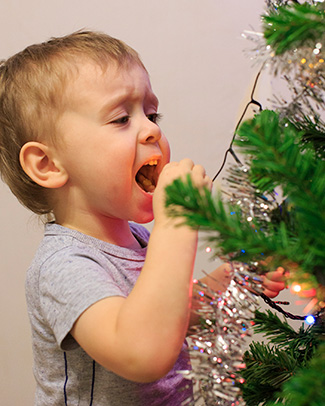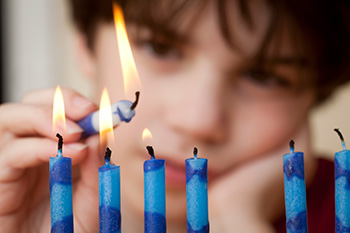Our Top 12 Safety Tips for the Season
 Even though the holidays are going to look and feel different this year, there are many holiday traditions and activities that won’t be impacted by the pandemic – decorating the house, lighting the fireplace and heading out for winter fun.
Even though the holidays are going to look and feel different this year, there are many holiday traditions and activities that won’t be impacted by the pandemic – decorating the house, lighting the fireplace and heading out for winter fun.
But holidays can also be accompanied by hazards. To help keep you and your family safe, here are recommendations from Dr. Carl P. Kaplan, Interim Chief, Division of Pediatric Emergency Medicine.
Holiday Lights
Be sure to use indoor lights inside and outdoor lights outside. Be certain there are no frayed or bare wires, broken bulbs or loose connections. Unplug holiday lights when they’re not in use, and if you have young children, plug the empty sockets with childproof caps.
Decorations
Keep glass ornaments, lit candles and tinsel out of reach of young children. Make sure all candle flames are extinguished before retiring for the evening. Electric candles are a super alternative.
Fireplaces
Children should always be closely monitored whenever they are near fireplaces. Use a screen on the fireplace when it’s in use and ensure the chimney has been cleaned at least once a year before lighting it. Don’t burn holiday wrapping in the fireplace.
 Space Heaters
Space Heaters
Ensure that space heaters are safe for indoor use and are not kept where children can reach them or tip them over. Never use a heater or device which requires fuel such as gasoline or kerosene inside your home.
Toys
The age recommendations you see on toy packaging are for safety reasons, such as choking prevention. Make sure that toys your children use are age-appropriate, and, if they’re not, put them away for future fun. If there are younger children around, be mindful, they may try to join in and pick up the older ones’ toys or game pieces.
Sledding, Skating and Skiing
Kids should continue to be active outdoors, even in cold weather. If they’re sledding, skiing or skating make sure they wear a properly fitted helmet, and know the rules for safe play to avoid getting hurt or hurting others. If they start to complain of pain in their fingers, toes, ears or nose it may be time to come in from the cold.
Dressing in Layers
Wearing multiple thin layers, rather than a single thick one, can help keep your child warmer because warm air is trapped in the layers. The outside layer should be water and wind-resistant.
Smoke and Carbon Monoxide Detectors
All the detectors in your home should be checked annually to ensure that they’re in good working order. If you have battery operated devices, change the batteries each year.
Seasonal and Holiday Beverages
Scalding hot cocoa or cider can cause mouth and skin burns. Be sure to temperature-test all warm drinks before serving them to kids. And remember that sweet alcoholic drinks, such as eggnog or spiked cider, can taste good to kids but be dangerous if they’re consumed.
Alcohol and Winter Machinery
Remember that sleds, snowmobiles and ATVs are also vehicles, which means alcohol use should be avoided when operating them.
Medicines
Brightly colored pills can resemble candy. Make sure all medicines are always kept in childproof containers and out of reach of children.
In Case of Emergency
Many emergency room visits take place during the holiday season. If your child does need an emergency room visit, Stony Brook Children’s Hospital Pediatric Emergency Department offers many benefits other hospitals do not.
We have an extensive team, which includes board-certified pediatric emergency medicine physicians, pediatricians, pediatric NPs and pediatric critical care nurses. Our designation as Suffolk’s only Level 1 Pediatric Trauma Center, means we’re able to care for the most severely ill and injured infants, children and young adults. And our skilled staff is well trained in all kinds of methods to help reduce stress and minimize pain.
There’s also our dedicated space for children’s emergencies only, with a separate entrance and a child-friendly waiting room that protects children from seeing adult emergencies. Plus, many private treatment rooms. And, since we’re part of Suffolk County’s only children’s hospital, with access to pretty much every type of pediatric specialist there is, if your child needs to be admitted to the hospital, where else would you want to be?
Burn Care
Stony Brook University Hospital is also where you will find The Suffolk County Volunteer Firefighters Burn Center, the only designated burn care facility in Suffolk County. The key to managing any type of burn, but particularly the more severe kind, is to get appropriate treatment as quickly as possible. The Burn Center, which is open 24/7, provides the most sophisticated care to both adults and children with major burns and is certified by the American Burn Association.
In case of poisoning call Poison Control at 1-800-222-1222.

